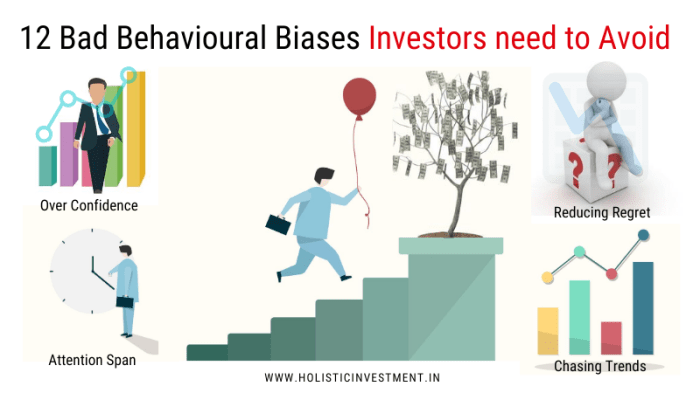Behavioral biases in investing take center stage in the financial world, influencing decisions and outcomes in ways we might not even realize. From overlooking crucial information to following the crowd, these biases can lead investors astray without them even knowing it. Dive into this captivating topic as we explore the fascinating realm of behavioral biases in investing.
Overview of Behavioral Biases in Investing

Behavioral biases in investing refer to the psychological tendencies or irrational behaviors that can influence investment decisions, often leading to suboptimal outcomes.
Understanding these biases is crucial for investors as it can help them recognize and avoid making costly mistakes driven by emotions rather than logic. By being aware of these biases, investors can make more informed and rational decisions, ultimately improving their overall investment performance.
Examples of Common Behavioral Biases
- Confirmation Bias: Investors tend to seek out information that confirms their existing beliefs or opinions while ignoring contradictory evidence. This can result in overlooking important data that may impact investment decisions.
- Loss Aversion: This bias refers to the tendency of investors to strongly prefer avoiding losses over acquiring gains of the same magnitude. As a result, investors may hold onto losing investments for too long in the hope of recovering losses, even when it may not be the best decision.
- Herding Behavior: This bias occurs when investors follow the actions of the crowd without conducting their own independent analysis. It can lead to market bubbles or crashes as individuals make investment decisions based on the actions of others rather than on fundamental analysis.
- Overconfidence: Investors may overestimate their abilities and knowledge, leading them to take excessive risks or trade too frequently. This can result in poor investment performance as a result of unwarranted confidence in their decision-making skills.
Types of Behavioral Biases
Investors are often influenced by various behavioral biases that can affect their decision-making process and ultimately impact their investment outcomes. Understanding these biases is crucial for investors to make more informed and rational investment choices.
Confirmation Bias
Confirmation bias is the tendency to seek out information that confirms one’s preexisting beliefs or opinions while ignoring or dismissing contradictory evidence. In investing, this bias can lead investors to only focus on information that supports their investment thesis, potentially overlooking warning signs or red flags that could result in poor investment decisions.
Loss Aversion
Loss aversion refers to the psychological tendency for individuals to strongly prefer avoiding losses over acquiring gains. This bias can cause investors to hold on to losing investments for longer than they should, hoping to avoid realizing a loss. This behavior can lead to missed opportunities for better investments and overall portfolio underperformance.
Herd Mentality
Herd mentality is the phenomenon where individuals tend to follow the actions of a larger group, often resulting in irrational decision-making. In investing, herd mentality can lead to asset bubbles or market crashes as investors blindly follow the crowd without conducting their own due diligence. This can create volatility in the market and impact investment returns negatively.
Overconfidence Bias
Overconfidence bias occurs when individuals overestimate their abilities or knowledge, leading them to take on more risk than they should. In investing, this bias can result in excessive trading, failure to diversify properly, and overall poor performance as investors become overconfident in their ability to beat the market.
Anchoring Bias
Anchoring bias is the tendency to rely too heavily on the first piece of information encountered when making decisions. In investing, this bias can cause investors to anchor on a specific price point or valuation, even if new information suggests that the initial assumptions are no longer valid. This can result in missed opportunities or holding onto investments longer than necessary.
Behavioral Biases vs. Rational Decision-Making
In the world of investing, the clash between behavioral biases and rational decision-making is a constant battle. While rational decision-making involves making choices based on logic, evidence, and analysis, behavioral biases are psychological tendencies that can lead investors astray, causing them to make decisions based on emotions or cognitive shortcuts rather than facts.
Why Investors Succumb to Biases
Despite knowing what the rational choice should be, investors often succumb to behavioral biases for several reasons. One of the main reasons is the influence of emotions like fear and greed, which can cloud judgment and lead to impulsive decision-making. Additionally, cognitive biases such as overconfidence or anchoring can also distort the way investors perceive information, making them more susceptible to making irrational choices.
- Emotional Influence: Emotions like fear and greed can override rational thinking and lead to impulsive decisions.
- Cognitive Biases: Mental shortcuts or biases like overconfidence or anchoring can distort perception and influence decision-making.
Mitigating Bias Influence
To mitigate the influence of biases and make more rational investment decisions, investors can employ various strategies and techniques. One effective approach is to create a structured investment plan and stick to it, regardless of short-term market fluctuations or emotional impulses. Diversifying investments across different asset classes can also help reduce the impact of biases by spreading risk. Additionally, seeking advice from financial professionals or using technology like robo-advisors can provide objective insights and counteract the effects of cognitive biases.
By recognizing and acknowledging their own biases, investors can take proactive steps to counteract them and make more informed decisions.
Psychological Factors Driving Behavioral Biases
Investing decisions are often influenced by various psychological factors, leading to behavioral biases that can impact financial outcomes. Emotions and cognitive processes play a significant role in shaping how investors perceive and act in the market.
Emotions in Investor Behavior
- Fear: When investors are driven by fear, they may tend to make irrational decisions like selling off investments during market downturns, even when it’s not the best strategy in the long run.
- Greed: Greed can lead investors to take excessive risks in pursuit of high returns, overlooking potential downsides and making impulsive choices that may not align with their financial goals.
- Overconfidence: Overconfident investors may believe they have superior knowledge or skills, leading them to trade more frequently, which can increase transaction costs and reduce overall returns.
Cognitive Processes in Biased Decision-Making, Behavioral biases in investing
- Heuristics: Investors often rely on mental shortcuts or rules of thumb to make quick decisions, which can result in overlooking important information or adopting a biased view of the market.
- Mental Shortcuts: Cognitive biases like anchoring (fixating on initial information) or confirmation bias (seeking information that confirms existing beliefs) can influence investment choices and hinder rational decision-making.






